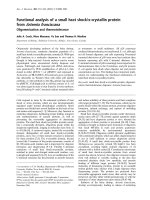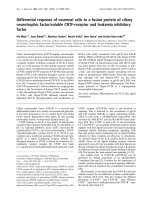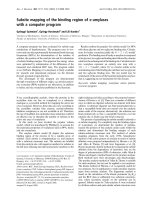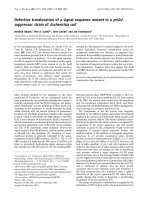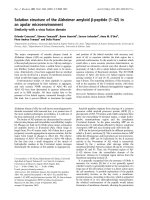Báo cáo y học: "Too much of a good thing: the curse of overfeeding" docx
Bạn đang xem bản rút gọn của tài liệu. Xem và tải ngay bản đầy đủ của tài liệu tại đây (40.2 KB, 2 trang )
Page 1 of 2
(page number not for citation purposes)
Available online />Abstract
Enteral nutrition (EN) gives a legacy of under nutrition in intensive
care patients but few appreciate that parenteral nutrition (PN)
carries the other risk of overfeeding if used injudiciously. Over-
feeding presents a significant metabolic stress but tight glycaemic
control is now masking the traditional warning signs and does not
on its own negate the need to give patients the right amount at the
right time.
Natural selection has refined our ability to handle acute
infection and short-term starvation but has not prepared us
for the excesses of modern life and intensive care practice.
There are two key lessons from the observational study by
Dissanaike and co-workers [1] who have studied parenterally
fed patients in the era of tight glycaemic control. Firstly,
parenteral nutrition (PN) as practiced by intensive care
doctors can result in serious overfeeding and secondly this
overfeeding impacts on infectious morbidity. The title
unfortunately does not address the more serious issue of
overfeeding that occurs when this route of nutrition delivery is
abused. Of course this perpetuates the misguided view that it
is PN that is a “poison” [2] rather than the real issue of
overfeeding.
As a warning about overfeeding the authors are to be
commended in exposing a rampant neglect of care that I am
sure is common across all but the most ardently nutrition
focussed intensive care units. It is obvious that parenteral
nutrition lends itself to inappropriate overfeeding just as
enteral nutrition (EN) is usually characterised by under-
feeding. Few appear to appreciate the extent to which
additional calories are administered intravenously. The
principle outcome observed of increased blood stream
infections is only an association with overfeeding and in an
observational study cannot be causally linked. Interestingly
there appeared no association with increased mortality.
Why then should there be a link between
nutritional excess and infection?
The principle calorie substrates of glucose and lipids have
well defined rates of utilisation and storage. When not given
in excess they are handled in a wide range of proportions in
the critically ill and septic patient [3] but whether given by
either the enteral or parenteral route because of insulin resis-
tance do not have the same metabolic consequences as in
the well state [4]. However overfeeding of either fats or
glucose stresses the metabolic tolerance and compounds
the impairment of storage associated with insulin resistance.
Obesity and the metabolic syndrome is the chronic equivalent
state, intimately linked with inflammation and complex signal-
ling interactions [5].
Critical to evolutionary survival has been our ability to with-
stand starvation and our capacity to mount an inflammatory
response to pathogens [6]. We therefore have a signalling
system that closely links nutrition sensing, storage and
inflammation and it should be of no surprise that our liver and
adipose tissues have an architectural organisation in which
metabolic cells are in close proximity to immune cells (Kupffer
cells and macrophages respectively). Indeed this interface
and signalling is believed to be behind the development of
metabolic disease and inflammation in obesity and diabetes
[7]. Interestingly the lowly Drosophila has only one structure,
a fat body that efficiently combines the immune, adipose cell
and hepatic cell functions in one organ system [8]. This
provides a configuration that enables close integrated
communication (and in man also with skeletal muscle) and
ensures the right nutrient provision to mount the inflammatory
response. However it did not evolve in the context of
continuous nutrient delivery, nor I suspect with sustained
immobility! The endoplasmic reticulum (ER) and the signal
interaction on this complex structure are particularly sensitive
to nutrient signalling and are the focus of much metabolic
Commentary
Too much of a good thing: the curse of overfeeding
Richard D Griffiths
Division of Metabolic & Cellular Medicine, School of Clinical Sciences, University of Liverpool, Liverpool, L69 3GA, UK
Corresponding author: Richard D Griffiths,
Published: 9 November 2007 Critical Care 2007, 11:176 (doi:10.1186/cc6165)
This article is online at />© 2007 BioMed Central Ltd
See related research by Dissanaike et al., />EN = enteral nutrition; ER = endoplasmic reticulum; ICU = intensive care unit; NICE = National Institute for Health and Clinical Excellence; PN =
parenteral nutrition.
Page 2 of 2
(page number not for citation purposes)
Critical Care Vol 11 No 6 Griffiths
research [5]. Evidence suggests that with substrate excess
there are metabolically induced increased oxidative
processes, increased reactive oxygen species, and increased
storage challenges carrying consequences for ER stress
signalling through the major inflammatory pathways. It is a
reasonable hypothesis that nutritional excess in intensive care
unit (ICU) patients confounds many aspects of immune
function and increases the oxidative load.
So what does this mean for clinical practice?
This debate has little to do with the route of nutrition but
everything to do with the content and amount of nutrition. In
intensive care modern PN does not carry increased risk [9];
indeed the EN v PN debate was recognised as futile by the
UK Nutrition guidelines published by the National Institute for
Health and Clinical Excellence (NICE) [10]. This emphasised
a stepwise progression moving from oral to the more invasive
enteral and parenteral approaches based upon need and risk
but also cautioned about excess and avoidance of the re-
feeding syndromes.
Based upon observational evidence that outcome is better in
those fed only two-thirds of their “requirements” [11] an oft
quoted argument is that it is “safer” to give hypocaloric
feeding. However the observation could be showing that it is
easier to overfeed the sicker and poorer outcome patients in
whom it might be more critical to have properly matched
delivery to their requirements. Hypocaloric feeding only
exacerbates the calorie deficit that has a legacy in the long
term [12]. Perhaps getting it right by improving our
measurements is needed [13].
Can we generalise upon these observations?
The study used a multiple infusion PN and infused substrates
at different times that might have increased metabolic stress;
and the absence of glutamine in the amino acid solutions may
have contributed to infectious morbidity risk and outcome
[14]. The final concern is that in the era of tight glycaemic
control clinicians could be masked from the signs of
overfeeding. Hyperglycaemia in the past would have resulted
in a reduction in the feed delivery, although avoiding hyper-
glycaemia insulin therapy will simply facilitate the metabolic
stress if overfeeding is not avoided. Lack of attention to
nutrition detail may be why the second round of multi-centre
studies (as yet unpublished) are finding it hard to replicate
the pioneering single centre studies (by Professor Greet Van
den Berghe and colleagues in Leuven, Belgium). Her studies
received criticism because of the use of parenteral delivery
but a recent paper [15] tabulates the nutrition delivery and
shows neither under delivery nor overfeeding with total mean
daily kilocalorie intakes ranging between 15 and 25 kcal/kg/day.
Be warned you can have too much of a good thing.
Competing interests
RDG has received small research project grants from
Fresenius Kabi (not within the last 2 years) and occasional
travel expenses to speak at international conferences. He has
no direct association with any commercial company.
References
1. Dissanaike S, Shelton M, Warner K, O’Keefe GE: The risk for
bloodstream infections is associated with increased par-
enteral caloric intake in patients receiving parenteral
nutrition. Critical Care 2007, 11:R114.
2. Marik PE, Pinsky M: Death by parenteral nutrition. Intensive
Care Med 2003, 29:867-869.
3. Tappy L, Schwarz JM, Schneiter P, Cayeux C, Revelly JP,
Fagerquist CK, Jequier E, Chiolero R: Effects of isoenergetic
glucose-based or lipid-based parenteral nutrition on glucose
metabolism, de novo lipogenesis, and respiratory gas
exchanges in critically ill patients. Crit Care Med 1998, 26:
860-867.
4. Tappy L, Berger M, Schwarz JM, McCamish M, Revelly JP,
Schneiter P, Jequier E, Chiolero R: Hepatic and peripheral
glucose metabolism in intensive care patients receiving con-
tinuous high- or low-carbohydrate enteral nutrition. JPEN J
Parenter Enteral Nutr 1999, 23:260-267.
5. Hotamisligil GS: Inflammation and metabolic disorders. Nature
2006, 444:860-867.
6. Levin BR, Lipsitch M, Bonhoeffer S: Population biology, evolu-
tion, and infectious disease: convergence and synthesis.
Science 1999, 283:806-809.
7. Shoelson SE, Lee J, Goldfine AB: Inflammation and insulin
resistance. J Clin Invest 2006, 116:1793-1801.
8. Sondergaard L: Homology between mammalian liver and the
Drosophila fat body. Trends Genet 1993, 9:193.
9. Griffiths RD: Is parenteral nutrition really that risky in the
intensive care unit? Curr Opin Clin Nutr Metab Care 2004, 7:
175-81.
10. National Institute for Health and Clinical Excellence: Nutrition
Support in adults [www.nice.org.uk/CG032].
11. Krishnan JA, Parce PB, Martinez A, Diette GB, Brower RG:
Caloric intake in medical ICU patients: consistency of care
with guidelines and relationship to clinical outcomes. Chest
2003, 124:297-305.
12. Berger MM, Chiolero RL: Hypocaloric feeding: pros and cons.
Curr Opin Crit Care 2007, 13:180-186.
13. Dvir D, Cohen J, Singer P: Computerised energy balance and
complications in critically ill patients: an observational study.
Clin Nutr 2006, 25:37-44.
14. Bongers T, Griffiths RD, McArdle A: Exogneous glutamine; the
clinical evidence. Crit Care Med 2007, 35(9 Suppl):S545-
S552.
15. Van den Berghe G, Wilmer A, Milants I, Wouters PJ, Bouckaert B,
Bruyninckx F, Bouillon R, Schetz: Intensive insulin therapy in
mixed medical/surgical intensive care unit: Benefits versus
harm. Diabetes 2006, 55:3151-3159.



